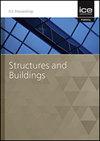钢管柱与混凝土框架连接环梁的抗震性能
IF 1.4
4区 工程技术
Q3 CONSTRUCTION & BUILDING TECHNOLOGY
Proceedings of the Institution of Civil Engineers-Structures and Buildings
Pub Date : 2022-08-12
DOI:10.1680/jstbu.21.00173
引用次数: 0
摘要
对钢管混凝土柱和钢筋混凝土框架环梁连接体系的抗震性能进行了研究。对两个预制试件进行了单调和循环加载下的物理试验。结果表明,该连接体系的位移延性比为4.68,耗能系数大于2.0。建立了有限元模型,并对骨架曲线和刚度退化趋势进行了数值与实验对比。然后进行了参数化研究,以评估轴压比、环梁节点的混凝土强度和配筋率以及框架梁的配筋率对所提出的连接系统抗震性能的影响。结果表明:增大混凝土材料的轴压比或强度会提高连接体系的初始刚度和强度;而连接体系环梁节点配筋率和框架梁配筋率对结构抗震性能的影响可以忽略不计。本文章由计算机程序翻译,如有差异,请以英文原文为准。
Seismic performance of a ring beam connecting filled-tube columns with concrete frames
The seismic performance of a ring-beam connection system that integrates concrete-filled steel tubular columns and reinforced concrete frames was studied. Physical experiments on two fabricated specimens were conducted under monotonic and cyclic loading. The results showed the connection system had a displacement ductility ratio of 4.68 and an energy dissipation coefficient over 2.0. A finite-element model was established and the numerical and experimental results were compared in terms of skeleton curve and stiffness degradation trend. Parametric studies were then performed to evaluate the effects of axial compressive force ratio, concrete strength and reinforcement ratio for the ring-beam joint, and reinforcement ratio for the frame beam, on the seismic performance of the proposed connection system. The results indicated that the increase in the axial compression ratio or strength of the concrete material would improve the initial stiffness and strength of the connection system. However, the effect of the ring-beam joint reinforcement ratio and frame beam reinforcement ratio of the connection system on the seismic performance was negligible.
求助全文
通过发布文献求助,成功后即可免费获取论文全文。
去求助
来源期刊
CiteScore
3.40
自引率
6.20%
发文量
61
审稿时长
12 months
期刊介绍:
Structures and Buildings publishes peer-reviewed papers on the design and construction of civil engineering structures and the applied research associated with such activities. Topics include the design, strength, durability and behaviour of structural components and systems.
Topics covered: energy conservation, people movement within and around buildings, strength and durability of steel and concrete structural components, and the behaviour of building and bridge components and systems

 求助内容:
求助内容: 应助结果提醒方式:
应助结果提醒方式:


